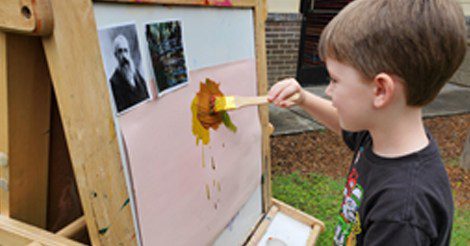Observe Famous Artists and Art Styles!
 This month we are exploring classical artists and art styles through pictures, books, and fun hands-on activities. We are creating art as a personal response to our feelings conjured by viewing art, and are expressing these feelings through a variety of mediums on the art easel. After exploring the history, process, and meaning of the artist’s work, the children will enjoy experimenting with the very same medium that the artist used. This activity introduces a variety of developmental goals such as fine motor skill development, sensory exploration, and expansion and articulation of personal response, as well as conversational skills and speech. Academic goals include history of classical artists, differentiating between various styles and mediums of art, and exploring a variety of art tools. Your child will love this messy, hands-on learning experience!
This month we are exploring classical artists and art styles through pictures, books, and fun hands-on activities. We are creating art as a personal response to our feelings conjured by viewing art, and are expressing these feelings through a variety of mediums on the art easel. After exploring the history, process, and meaning of the artist’s work, the children will enjoy experimenting with the very same medium that the artist used. This activity introduces a variety of developmental goals such as fine motor skill development, sensory exploration, and expansion and articulation of personal response, as well as conversational skills and speech. Academic goals include history of classical artists, differentiating between various styles and mediums of art, and exploring a variety of art tools. Your child will love this messy, hands-on learning experience!
Age-appropriate Adaptations:
- Two-year-olds—Your child can explore pictures of paintings created by classical artists, and can be given a choice of mediums to create their own art with paints, crayons, and chalk. A great idea for the introduction of a classical artist is Van Gogh and simple brush strokes. Show your child how to paint with a paintbrush, draw with chalks, and mix colors to create new ones! Fine motor skills and science skills are emphasized in this adaption of our creative art activity.
- Three-year-olds—The exploration of the artist’s work, as well as the face of the artist, will help your child connect their work to the creation of the artist. Extending the medium selection to include not only paint, crayons, and chalk, but also homemade puff paint, will turn this activity into a rich sensory and science experience. A trip to the local art museum to explore original works of art will also enrich the activity and help your child to retain the information they’ve learned about the artist.
- Four-/Five-year-olds—In addition to a trip to the local museum, and exploring original art and photos of the artist, exploring professional art tools in a craft store will enrich their experience in learning the value of art in our society. To extend art activities across the science and sensory domains, your child can mix their own paint and create their own mediums such as sand paint, puff paint, and bubble paint. Your child will be learning across a variety of domains and will be having fun in the process!
Skills Supported: conversation of their feelings on various art pieces and the historical significance of classical artists, fine motor skills (gripping the art tools), imagination, scientific experimentation, practicing personal response to pieces of art, and sensory exploration.
